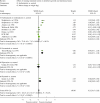A review and meta-analysis of the impact of intestinal worms on child growth and nutrition
- PMID: 18289159
- PMCID: PMC6860651
- DOI: 10.1111/j.1740-8709.2007.00127.x
A review and meta-analysis of the impact of intestinal worms on child growth and nutrition
Abstract
More than a half of the world's population are infected with one or more species of intestinal worms of which the nematodes Ascaris lumbricoides, Trichuris trichiura and the hookworms are the most common and important in terms of child health. This paper: (1) introduces the main species of intestinal worms with particular attention to intestinal nematodes; (2) examines how such worms may affect child growth and nutrition; (3) reviews the biological and epidemiological factors that influence the effects that worms can have on the growth and nutrition of children; (4) considers the many factors that can affect the impact of treatment with anthelmintic drugs; (5) presents the results of a meta-analysis of studies of the effect of treating worm infections on child growth and nutrition; (6) discusses the results in terms of what is reasonable to expect that deworming alone can achieve; (7) describes some important characteristics of an ideal study of the effects of deworming; and (8) comments on the implications for programmes of recommendations concerning mass deworming.
Figures


























References
-
- Adams E., Stephenson L., Latham M. & Kinoti S. (1994) Physical activity and growth of Kenyan school children with hookworm, Trichuris trichiura and Ascaris lumbricoides infections are improved after treatment with albendazole. Journal of Nutrition 124, 1199–1206. - PubMed
-
- Aguayo V.M. (2000) School‐administered weekly iron supplementation – effect on the growth and hemoglobin status of non‐anemic Bolivian school‐age children. A randomized placebo‐controlled trial. European Journal of Nutrition 39, 263–269. - PubMed
-
- Al‐Mekhlafi H.M.S., Shaik A., Ismail M.G., Sa’iah A., Azlin M., Aini U.N. et al (2005) Protein‐energy malnutrition and soil‐transmitted helminthiases among Orang Asli children in Selangor, Malaysia. Asia Pacific Journal of Clinical Nutrition 14, 188–194. - PubMed
-
- Albonico M., Smith P.G., Hall A., Chwaya H.M., Alawi K.S. & Savioli L. (1994) A randomized controlled trial comparing mebendazole and albendazole against Ascaris, Trichuris and hookworm infections. Transactions of the Royal Society of Tropical Medicine and Hygiene 88, 585. - PubMed
-
- Albonico M., Stoltzfus R.J., Savioli L., Tielsch J.M., Chwaya H.M., Ercole E. et al (1998) Epidemiological evidence for a differential effect of hookworm species, Ancylostoma duodenale or Necator americanus, on iron status of children. International Journal of Epidemiology 27, 530–537. - PubMed
Publication types
MeSH terms
Substances
LinkOut - more resources
Full Text Sources
Other Literature Sources
Medical

